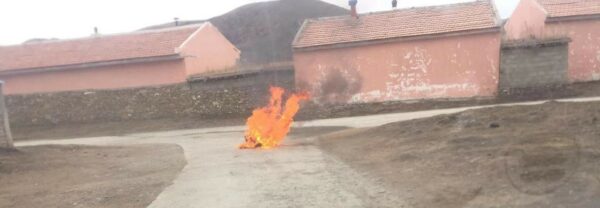Content warning: This report contains a graphic image
A young Tibetan former monk from Kirti monastery set himself on fire on Tuesday afternoon, Nov. 26, and died in Ngaba (Chinese: Aba) Tibetan and Qiang Autonomous Prefecture, Sichuan, in the Tibetan area of Amdo. It was the first known self-immolation by a Tibetan this year.
Despite the intense restrictions that Chinese authorities have placed on sharing information with the outside world, images reached Tibetans in exile of 24-year-old Yonten alone and ablaze on a road somewhere in the pastoral area of Me’uruma, Ngaba, where the wave of Tibetan self-immolations began in 2009 when Kirti monk Tapey walked out of his monastery and set himself on fire.

Since then, there have been a total of 156 Tibetan self-immolations in Tibet and China, including Yonten’s.
According to two Kirti monks living in exile, Kanyag Tsering and Lobsang Yeshe, Yonten joined Kirti monastery when he was very young and later returned to lay life and worked as a pastoralist. One of the images of Yonten received today show him with a camera.
Three self-immolations in Ngaba last year
Yonten’s self-immolation comes nearly a year after a man named Drugkho is said to have set himself on fire on Dec. 8, 2018. It was one of three self-immolations in Tibet last year, all of them males in Ngaba.
There is still no full confirmation of Drugkho’s self-immolation and details remain sketchy due to China’s comprehensive information blackout in Tibetan areas.
On Nov. 4, 2018, a 23-year-old man called Dorbe set himself on fire in a pastoral township of Ngaba saying: “May the Dalai Lama live long! May we soon behold his golden countenance!” before he died.
Dorbe’s self-immolation followed the death of a man in his 40s, Tsekho Tugchak, who set fire to himself on March 7, 2018, also in Ngaba. Graphic images circulated online at the time of Tsekho Tugchak’s blackened body lying on the ground, his arms outstretched. He was from the same area as Yonten, a nomadic village in Me’uruma township.
Chinese response
Chinese authorities have responded to the wave of self-immolations in Ngaba from 2009 onward by intensifying their security measures to a stifling degree and strengthening the policies and measures that are the root cause of the acts, such as aggressive campaigns against the Dalai Lama.
Chinese authorities have taken violent retributive actions against families, relatives or monasteries associated with those who have self-immolated, which creates a vicious spiral of deeper oppression, leading to more self-immolations.
The suffering of the family of Tsekho, who self-immolated in March 2018 in the same pastoral area as Yonten, shows the impact of such oppression. In 2008, Tsekho’s half-brother, a Namtso monk named Nying-la, was tortured in prison and released with critical injuries, according to Kirti monks in exile. He died a few months later.
Another relative on his father’s side, Urgyen Gyatso, the Namtso monastery disciplinarian, was also arrested and imprisoned at that time. Tsekho joined Namtso monastery as a child, but later disrobed.
On Dec. 23, 2017, Konpe, a Tibetan who was also from Ngaba, set himself on fire close to the area of the first self-immolation in Tibet in February 2009.

Ngaba resistance
Tibetans in Ngaba are known for their strong sense of identity and resistance to Chinese rule over several generations, and China’s crackdown in the region has been particularly severe since March 2008. At least 18 people were killed when police opened fire on crowds of demonstrators who took to the streets in Ngaba with homemade Tibetan flags and images of the Dalai Lama on March 16, 2008. Among the dead was a 16-year-old Tibetan schoolgirl, Lhundup Tso.
It was on the anniversary of this protest on March 16, 2011 that Kirti monk Phuntsog set fire to himself and died on the street outside the monastery that has now become known as “Heroes” or “Martyrs” road, the intersection between the monastic and secular community in Ngaba.
Following Phuntsog’s death in 2011, the number of Tibetans setting themselves on fire increased. A Tibetan from Ngaba wrote a letter at that time that says: “What China’s leaders have to understand is that ethnic allegiance is a natural and unstoppable force, and ultimately people are loyal to their own kind and their own forebears. The more it is repressed, the stronger it becomes.”
Kirti monastery
Kirti monastery, where Yonten was a monk as a child, is one of the largest and most important centers of religious education and practice in Tibet. Many Ngaba residents, including many monks, have gone into exile in India over the years and established large monastic institutes there.
In May 2008, Kirti monks wrote to their counterparts in exile in India, saying the suppression following the protests was “too much for our hearts to hear about, and too much for our eyes to witness.”
The two Kirti monks in exile, Kanyag Tsering and Lobsang Yeshe, who have documented the self-immolations and solo protests in the area and beyond for more than a decade, have recently published a comprehensive account, “Tibetan Self-Immolations from 1998 – 2018.”